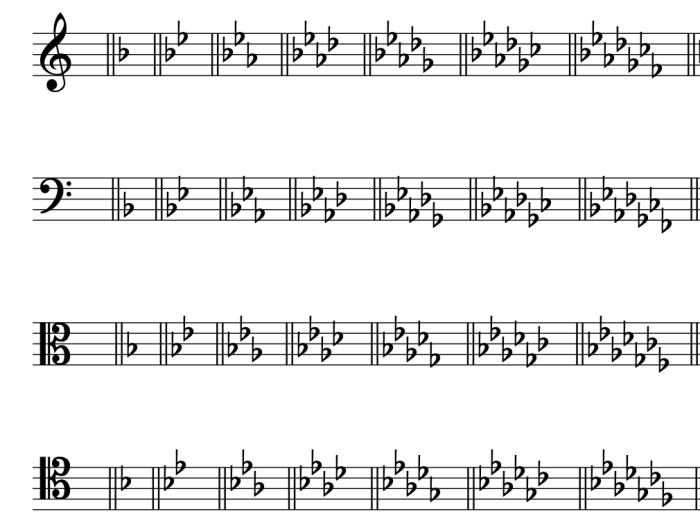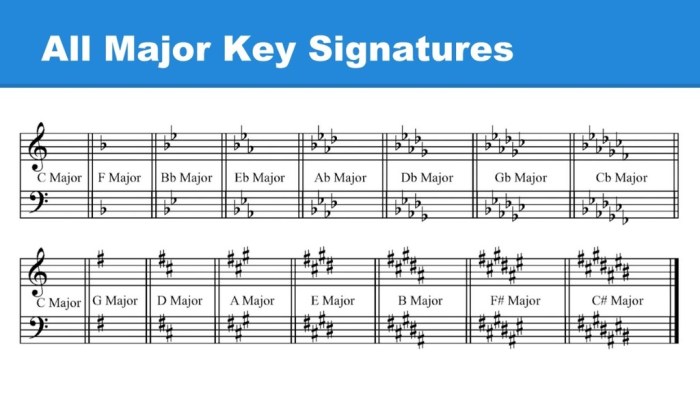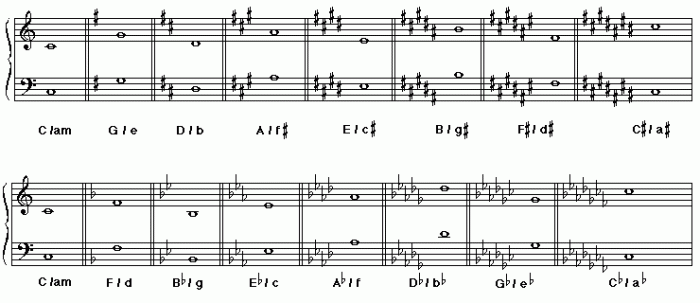D sharp minor bass clef – Embark on a musical journey as we delve into the enigmatic world of D sharp minor in the bass clef. This unique key, with its distinctive sound and expressive qualities, has captivated musicians for centuries. Join us as we explore the intricacies of D sharp minor, from its musical notation to its captivating uses in various genres.
Unveiling the key signature and fingerings for bass guitar and double bass, we’ll unravel the secrets behind its distinctive character. Prepare to be immersed in the rich soundscapes evoked by this minor key as we uncover its emotional depth and versatility.
Definition of D Sharp Minor Bass Clef

D sharp minor in the bass clef is a musical notation that indicates a minor scale starting from the note D sharp.
The corresponding fingerings on a bass guitar or double bass are as follows:
Bass Guitar
- Root: 2nd fret, A string
- Minor 2nd: 3rd fret, D string
- Major 3rd: 4th fret, G string
- Perfect 4th: 5th fret, D string
- Perfect 5th: 7th fret, A string
- Minor 6th: 8th fret, D string
- Major 7th: 10th fret, G string
Double Bass
- Root: Open E string
- Minor 2nd: 1st fret, A string
- Major 3rd: 2nd fret, D string
- Perfect 4th: 3rd fret, G string
- Perfect 5th: 5th fret, D string
- Minor 6th: 6th fret, A string
- Major 7th: 8th fret, D string
Characteristics of D Sharp Minor

D sharp minor is a minor key that has a unique sound and mood. It is often described as being dark, mysterious, and intense.
Key Signature
The key signature of D sharp minor has six sharps (#): F#, C#, G#, D#, A#, and E#.
Sound and Mood
The sound of D sharp minor is characterized by its dark and intense harmonies. The key is often used to create a sense of mystery or suspense. It can also be used to evoke feelings of sadness or longing.
Uses of D Sharp Minor: D Sharp Minor Bass Clef

D sharp minor is a versatile key that has been used in a wide range of musical genres throughout history. Its unique and expressive qualities have made it a favorite among composers seeking to evoke strong emotions and create dramatic effects.
D sharp minor bass clef is a musical notation used to indicate the pitch of notes in the bass clef. It is commonly used in classical music and jazz. If you’re preparing for the a&p exam 1 chapters 1-3 , understanding d sharp minor bass clef is essential.
This exam covers the basics of anatomy and physiology, including the structure and function of the human body. By studying d sharp minor bass clef, you can better understand the musical notation used in classical and jazz music.
Famous Musical Pieces in D Sharp Minor
Some of the most famous classical pieces written in D sharp minor include:
- Sergei Rachmaninoff’s Piano Concerto No. 2
- Frédéric Chopin’s Nocturne No. 20
- Alexander Scriabin’s Piano Sonata No. 5
In the realm of popular music, D sharp minor has also been used to create memorable and emotionally charged songs, such as:
- The Beatles’ “Yesterday”
- Queen’s “Bohemian Rhapsody”
- Adele’s “Someone Like You”
Emotional Impact and Expressive Qualities
The key of D sharp minor is often associated with feelings of sadness, longing, and melancholy. Its use in classical music has often been employed to create a sense of tragedy or loss. In popular music, D sharp minor has been used to convey a wide range of emotions, from the bittersweet nostalgia of “Yesterday” to the raw heartbreak of “Someone Like You.”The
expressive qualities of D sharp minor are largely due to its harmonic structure. The presence of the sharp seventh (C sharp) creates a sense of tension and instability, while the minor third (F sharp) contributes to the key’s overall somber and reflective mood.
Theory and Practice

In theory and practice, understanding the notes and intervals within a scale is crucial for developing proficiency in playing it. Similarly, practicing scales and chords in a particular key helps improve dexterity and strengthens muscle memory.
Notes and Intervals in D Sharp Minor Scale
| Degree | Note | Interval from Tonic |
|---|---|---|
| 1 | D# | Tonic |
| 2 | E# | Major Second |
| 3 | F## | Augmented Second |
| 4 | G# | Perfect Fourth |
| 5 | A# | Augmented Fifth |
| 6 | B | Major Sixth |
| 7 | C## | Augmented Seventh |
Exercises and Techniques for Practice, D sharp minor bass clef
To enhance your proficiency in D sharp minor, incorporate the following exercises and techniques into your practice routine:
- Scales:Practice playing the D sharp minor scale ascending and descending in different octaves.
- Arpeggios:Focus on playing the D sharp minor triad (D#, F##, A#) and its inversions in various positions.
- Chord Progressions:Explore chord progressions that utilize the D sharp minor chord, such as D#m – G#7 – C#maj7.
- Improvisation:Experiment with improvising melodies and solos over the D sharp minor scale.
Comparison to Other Minor Keys

The key of D sharp minor shares some similarities with other minor keys in the bass clef, particularly in terms of its overall structure and melodic contour. However, it also possesses unique characteristics that distinguish it from other minor keys.
Similarities to Other Minor Keys
- Melodic Contour:Like all minor keys, D sharp minor features a characteristic melodic contour marked by a descending minor third interval from the tonic to the mediant (D# to F#) and a subsequent ascending minor third interval from the mediant to the subdominant (F# to A).
- Chord Structure:The chords in D sharp minor share the same basic structure as those in other minor keys. The tonic triad (D#, F#, A) consists of a root, minor third, and perfect fifth, while the subdominant triad (A, C#, E) comprises a root, minor third, and perfect fifth.
Differences from Other Minor Keys
- Tonal Center:The key of D sharp minor has a unique tonal center that sets it apart from other minor keys. The use of the raised leading tone (C#) creates a sense of tension and instability that is not present in other minor keys.
- Harmonic Color:The presence of the raised leading tone in D sharp minor alters the harmonic color of the key. The resulting chords often have a more dissonant and chromatic sound compared to chords in other minor keys.
Creative Applications
D sharp minor, with its unique and expressive sound, opens up a world of creative possibilities for musicians. It offers a rich palette of emotions, from introspective and somber to passionate and intense.
In this section, we will explore how to harness the power of D sharp minor in songwriting and improvisation, unlocking its full creative potential.
Chord Progression Using D#m as Root
One way to explore the sonic landscape of D sharp minor is through chord progressions. A well-crafted chord progression can create a sense of movement and direction, evoking different moods and emotions.
Here is an example of a chord progression using D sharp minor as the root:
- D#m (root)
- F#m (ii)
- G#m (iii)
- A#m (iv)
- C#m (vi)
- Bbm (VII)
- D#m (root)
This progression moves through the key’s diatonic chords, creating a sense of resolution and closure when it returns to the root chord.
Incorporating D#m into Songwriting and Improvisation
D sharp minor can also be effectively incorporated into songwriting and improvisation. Its distinct character can add depth and emotional resonance to your musical creations.
When songwriting in D sharp minor, consider using the key’s characteristic notes (D#, F#, and A#) to create melodies and harmonies. These notes will help establish the key and give your music a cohesive sound.
In improvisation, D sharp minor offers a fertile ground for exploration. The key’s rich harmonic possibilities allow you to experiment with different scales, modes, and chord voicings, creating unique and expressive solos.
Top FAQs
What is the key signature of D sharp minor?
The key signature of D sharp minor consists of seven sharps: F#, C#, G#, D#, A#, E#, and B#.
How is D sharp minor commonly used in music?
D sharp minor is often used to convey emotions of sadness, melancholy, and longing. It is frequently employed in classical, jazz, and rock music.
What are some famous pieces written in D sharp minor?
Notable examples include Rachmaninoff’s Prelude in D sharp minor, Chopin’s Nocturne No. 20 in D sharp minor, and Metallica’s “Nothing Else Matters.”